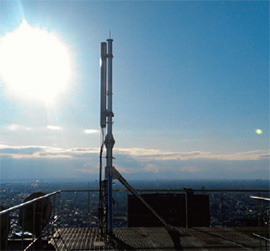- KDDI HOME
 Corporate Information
Corporate Information  Investor Relations
Investor Relations  IR Documents
IR Documents  Integrated Report
Integrated Report  Selected Pages of Integrated Report (2015)
Selected Pages of Integrated Report (2015)  ESG
ESG  Governance
Governance  Offering Reliable Information and Communications Services
Offering Reliable Information and Communications Services
Offering Reliable Information and Communications Services

- Material Issue:
Offering Reliable Information and Communications Services
Communications services are a lifeline for an advanced information society. Accordingly, KDDI places paramount importance on research dedicated to offering and improving reliable information and communications services.
We have formulated a robust corporate governance structure to ensure our ability to facilitate communications and to respond flexibly in the face of unforeseen circumstances.
Principal KPI: 100% improvement on issues identified in disaster response training
Providing Reliable Communications Services
KDDI owns an array of telecommunications facilities including optical cables and mobile phone base stations, which it maintains and operates via technical centers situated throughout Japan. At operations centers scattered across the country, we conduct centralized monitoring of telecommunications conditions 24 hours a day, 365 days a year. In the event of an outage, these centers control communications as appropriate, communicating with operational departments throughout Japan. With regard to communications service quality, we configure, analyze, and improve our facility operating system in line with the stringent standards that we have set for ourselves. In this manner, we strive to provide reliable communications services of consistently high quality.

Introducing 4G LTE-Capable Emergency-Use Wide-Zone Base Stations
KDDI has installed and begun operating emergency-use widezone base stations as part of its disaster backup procedures in preparedness for an earthquake striking below the Tokyo metropolitan area. The base stations support voice communications (1x), 3G communications (EVDO), and LTE communications (4G LTE), allowing provision of mobile phone services such as voice calls and data transmission should an earthquake directly hit the capital. These are the first 4G LTE-compatible wide-zone base stations in Japan.
Ten base stations have been constructed, covering an area from Chiba (in Chiba Prefecture) to the east to Kawaguchi (in Saitama Prefecture) to the north, Tachikawa (in Tokyo), and Kawasaki (in Kanagawa Prefecture) to the west. Furthermore, learning from our experience with the Great East Japan Earthquake in March 2011, the backhaul line (connected to the core network) in the wide-zone base station now has a dual structure of microwave radio and fiber optic cable.
We will study wide-zone base stations based on damage assumptions in each region of Japan in the event of disaster, not just in the Tokyo metropolitan area.

One of the wide-zone base station antennas on the roof of the KDDI Building in Shinjuku
Business Continuity Plan (BCP) for Large-Scale Disasters
Following the Great East Japan Earthquake, we established a Companywide Disaster Response Project, and in October 2011 formulated a BCP for Large-Scale Disasters. This plan establishes detailed rules for each phase of response to a disaster, from initial action through to full restoration. We are also creating satellite network links to principal bases throughout Japan in preparation for a scenario in which all fixed-line and mobile circuits cease to function. We have identified personnel who will, in the event of a disaster, be dispatched quickly to provide support at emergency shelters, and have stockpiled the equipment necessary for this eventuality. In addition to these measures to shore up our structure, we are proactively conducting disaster response training throughout Japan that focuses on initial disaster response.
In February 2015, the Disaster Response Office spearheaded efforts by countermeasure offices to link communications equipment from all divisions and branches throughout Japan as part of disaster response training in anticipation of an earthquake directly underneath the Tokyo metropolitan area. As well as employing a completely "blind" method of training in which participants are not told what sort of disaster to expect until just before the training begins, training was conducted assuming total disruption of communications immediately after the disaster, with the disaster response meeting held under a communications environment consisting only of satellite networks.
The training was held for approximately 300 emergency participants. At the start of the training, they responded as information about the disaster began to unravel and considered new damage assumptions that were disclosed as time went on, lending the training a sense of reality.
We will reflect in future BCPs the issues and areas for improvement that became apparent as a result of this training, building the foundations for more robust disaster response going forward.
- Recommended Contents
-




